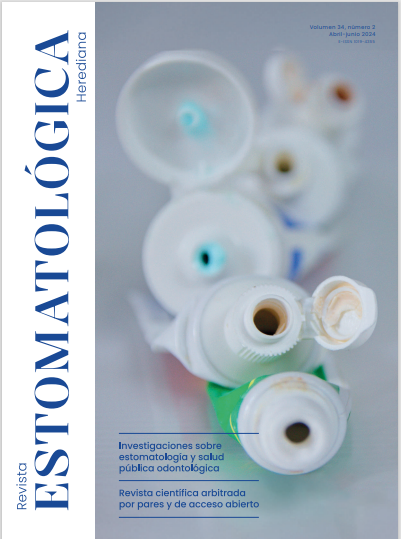Dens invaginatus: diagnóstico y manejo clínico. Revisión de literatura
DOI:
https://doi.org/10.20453/reh.v34i2.5535Palabras clave:
dens in dente, diagnóstico clínico, manejo de la enfermedad, revisión de literaturaResumen
El Dens invaginatus (DI) es una alteración dentaria que se produce antes de la mineralización y es consecuencia del plegamiento del órgano del esmalte dentro de la papila dental. Sus características permiten el inicio y avance rápido de la lesión cariosa y, en consecuencia, de la enfermedad pulpar y periapical. En el presente artículo se compendia datos pertenecientes a artículos originales y revisiones de literatura a partir de la base de datos Scopus/PubMed. Por lo tanto, el objetivo de la presente revisión de literatura es exponer las pautas para el manejo clínico del Dens invaginatus según su etiología, clasificación y diagnóstico; representando así una mejora en la efectividad del tratamiento y pronóstico de estas alteraciones muy complejas.
Descargas
Citas
Zhu J, Wang X, Fang Y, Von den Hoff JW, Meng L. An update on the diagnosis and treatment of dens invaginatus. Aust Dent J. 2017 Sep;62(3):261-275. doi: 10.1111/adj.12513. Epub 2017 May 22. PMID: 28306163.
Yalcin TY, Bektaş Kayhan K, Yilmaz A, Göksel S, Ozcan İ, Helvacioglu Yigit D. 2022. Prevalence, classification and dental treatment requirements of dens invaginatus by cone-beam computed tomography. PeerJ 10:e14450 https://doi.org/10.7717/peerj.14450
Volodymyr F. Treatment options for dens in dente: state-of-art literature review. Ukranian Dental Journal. 2022 Oct 1. DOI: 10.56569/UDJ.1.1.2022.37-42
González-Mancilla S, Montero-Miralles P, Saúco-Márquez JJ, Areal-Quecuty V, Cabanillas-Balsera D, Segura-Egea JJ. Prevalence of Dens Invaginatus assessed by CBCT: Systematic Review and Meta-Analysis. J Clin Exp Dent. 2022 Nov 1;14(11):e959-e966. doi: 10.4317/jced.59849. PMID: 36458027; PMCID: PMC9701346.
Pradhan B, Gao Y, He L, Li J. Non-surgical Removal of Dens Invaginatus in Maxillary Lateral Incisor Using CBCT: Two-year Follow-up Case Report. Open Med (Wars). 2019 Oct 19;14:767-771. doi: 10.1515/med-2019-0089. PMID: 31667354; PMCID: PMC6814960.
Oliveira Fonseca F, Canal Vasconcellos B, Martins Costa M, Ribeiro Sobrinho AP, Fonseca Tavares WL. Combined Endodontic and Surgical Therapy for Resolution of Type III Dens Invaginatus. Iran Endod J. 2020 Spring;15(2):117-123. doi: 10.22037/iej.v15i2.26882. PMID: 36704442; PMCID: PMC9709837.
Oehlers FA. Dens invaginatus (dilated composite odontome). I. Variations of the invagination process and associated anterior crown forms. Oral Surg Oral Med Oral Pathol. 1957 Nov;10(11):1204-18 contd. doi: 10.1016/0030-4220(57)90077-4. PMID: 13477660.
Kritika S, Bhandari SS, Benyöcs G, Villa Machado PA, Bishnoi N, Restrepo Restrepo FA, Karthikeyan K, Ataide I, Mahalaxmi S. Demystifying Dens Invaginatus: Suggested Modification of the Classification based on a Comprehensive Case Series. Eur Endod J. 2022 Mar;7(1):73-80. doi: 10.14744/eej.2021.48303. PMID: 35353060; PMCID: PMC9035864.
Gul M, Adnan S, Umer F. A Variant of the Current Dens Invaginatus Classification. Front Dent. 2020 Oct 29;17:28. doi: 10.18502/fid.v17i28.4654. PMID: 36042808; PMCID: PMC9375130.
Ludwig J, Reymus M, Winkler A, Soliman S, Krug R, Krastl G. Root Maturation of an Immature Dens Invaginatus Despite Unsuccessful Revitalization Procedure: A Case Report and Recommendations for Educational Purposes. Dent J (Basel). 2023 Feb 10;11(2):47. doi: 10.3390/dj11020047. PMID: 36826192; PMCID: PMC9955176.
Kfir A, Flaisher Salem N, Natour L, Metzger Z, Sadan N, Elbahary S. Prevalence of dens invaginatus in young Israeli population and its association with clinical morphological features of maxillary incisors. Sci Rep. 2020 Oct 13;10(1):17131. doi: 10.1038/s41598-020-74396-z. PMID: 33051551; PMCID: PMC7554044.
Alexoudi VA, Deligiannidis D, Antoniadis K, Tatsis D. Tooth within a tooth (dens in dente): A case report and a systematic review of population studies. Hellenic Arch Oral Maxillofac Surg. 2020;21(2) 95-102.
Hegde V, Mujawar A, Shanmugasundaram S, Sidhu P, Narasimhan S, Setzer FC, Nagendrababu V. Prevalence of dens invaginatus and its association with periapical lesions in a Western Indian population-a study using cone-beam computed tomography. Clin Oral Investig. 2022 Sep;26(9):5875-5883. doi: 10.1007/s00784-022-04545-3. Epub 2022 Jun 1. PMID: 35648236.
Ricucci D, Milovidova I, Siqueira JF Jr. Unusual Location of Dens Invaginatus Causing a Difficult-to-Diagnose Pulpal Involvement. J Endod. 2020 Oct;46(10):1522-1529. doi: 10.1016/j.joen.2020.07.004. Epub 2020 Jul 12. PMID: 32668311.
Abu Hasna A, Ungaro DMT, de Melo AAP, Yui KCK, da Silva EG, Martinho FC, Gomes APM. Nonsurgical endodontic management of dens invaginatus: a report of two cases. F1000Res. 2019 Dec 2; 8:2039. doi: 10.12688/f1000research.21188.1. PMID: 31885864; PMCID: PMC6915815.
Zubizarreta-Macho Á, Ferreiroa A, Agustín-Panadero R, Rico-Romano C, Lobo-Galindo AB, Mena-Álvarez J. Endodontic re-treatment and restorative treatment of a dens invaginatus type II through new technologies. J Clin Exp Dent. 2019 Jun 1; 11(6):e570-e576. doi: 10.4317/jced.55840. PMID: 31346380; PMCID: PMC6645261.
Arora S, Gill GS, Saquib SA, Saluja P, Baba SM, Khateeb SU, Abdulla AM, Bavabeedu SS, Ali ABM, Elagib MFA. Non-surgical management of dens invaginatus type IIIB in maxillary lateral incisor with three root canals and 6-year follow-up: A case report and review of literature. World J Clin Cases. 2022 Nov 26;10(33):12240-12246. doi: 10.12998/wjcc.v10.i33.12240. PMID: 36483835; PMCID: PMC9724506.
Lee HN, Chen YK, Chen CH, Huang CY, Su YH, Huang YW, Chuang FH. Conservative pulp treatment for Oehlers type III dens invaginatus: A case report. World J Clin Cases. 2019 Sep 26;7(18):2823-2830. doi: 10.12998/wjcc.v7.i18.2823. PMID: 31616698; PMCID: PMC6789382.
Ickow IM, Zinn S, Stacy JM Jr, Martin B, Losee JE, D'Alesio A, Soxman J, Schuster LA. Dens Invaginatus in Patients With Cleft Lip and Palate: A Case Series. Cleft Palate Craniofac J. 2021 Nov;58(11):1452-1458. doi: 10.1177/1055665621998534. Epub 2021 Mar 5. PMID: 33663245.
Descargas
Publicado
Cómo citar
Número
Sección
Licencia
Derechos de autor 2024 Revista Estomatológica Herediana

Esta obra está bajo una licencia internacional Creative Commons Atribución 4.0.
Los autores conservan los derechos de autor y ceden a la revista el derecho de primera publicación, con el trabajo registrado con la Licencia de Creative Commons, que permite a terceros utilizar lo publicado siempre que mencionen la autoría del trabajo, y a la primera publicación en esta revista.























